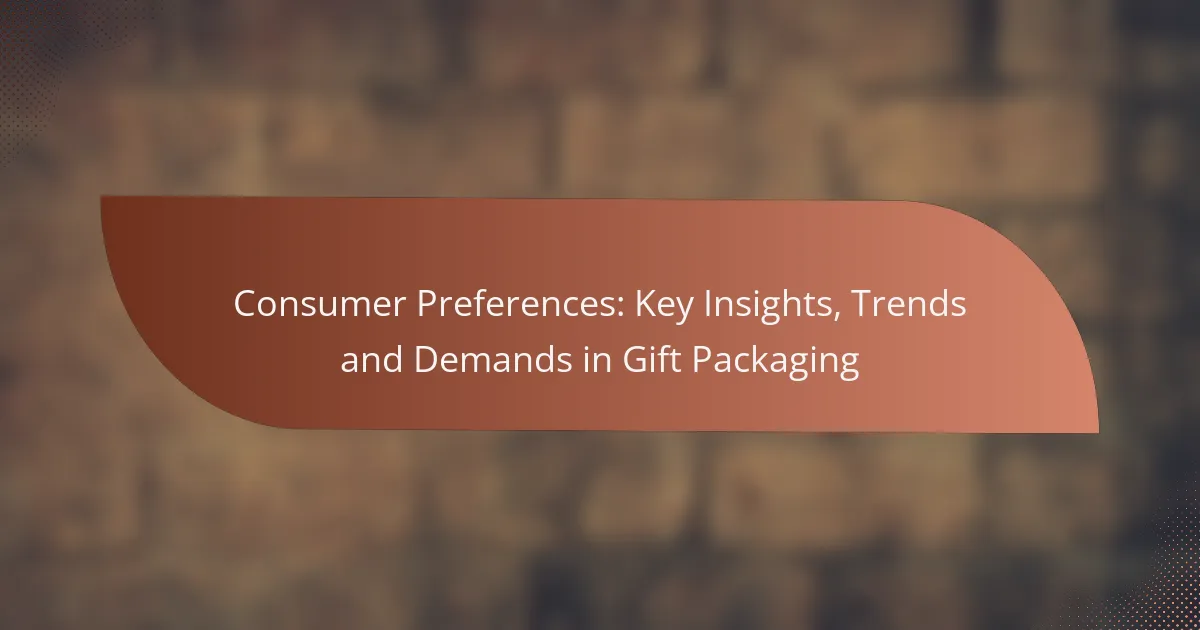Consumer preferences in gift packaging are evolving, with a strong emphasis on sustainability, personalization, and convenience. As shoppers become more discerning, trends such as minimalist designs and eco-friendly materials are shaping their purchasing decisions, enhancing both the aesthetic appeal and the overall gifting experience. Understanding these key insights is essential for brands aiming to align with consumer demands and stand out in the competitive market.
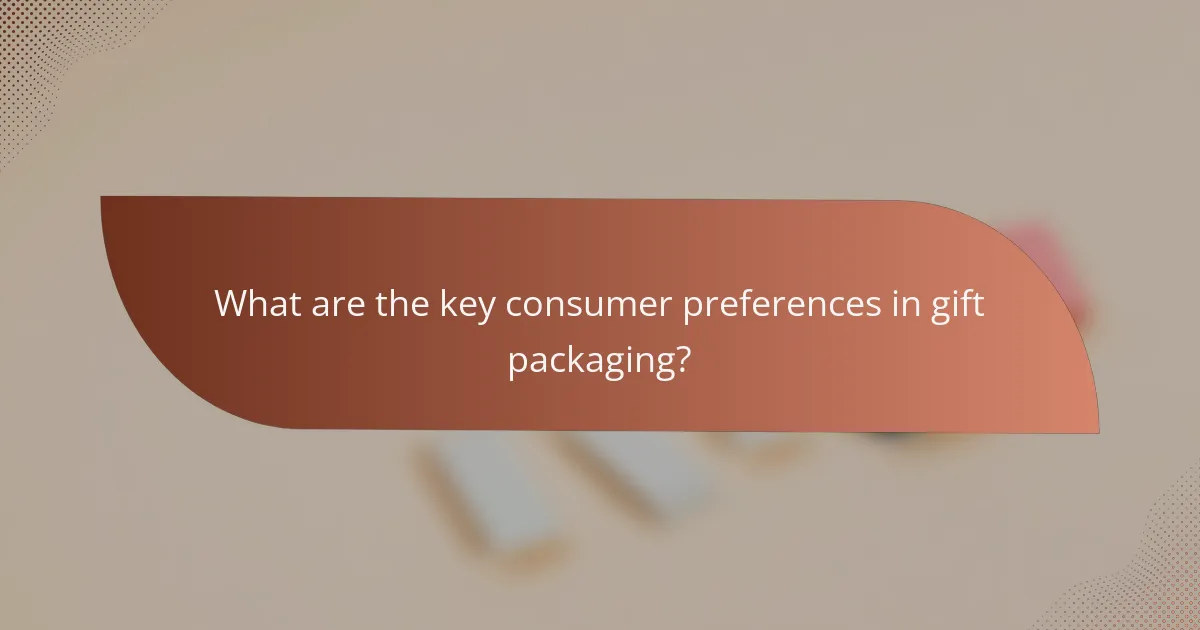
What are the key consumer preferences in gift packaging?
Key consumer preferences in gift packaging focus on sustainability, personalization, convenience, luxury, and brand alignment. These factors significantly influence purchasing decisions and enhance the overall gifting experience.
Eco-friendly materials
Consumers increasingly prefer gift packaging made from eco-friendly materials, such as recycled paper, biodegradable plastics, and plant-based inks. This trend reflects a growing awareness of environmental issues and a desire to reduce waste.
Brands can appeal to eco-conscious shoppers by clearly labeling their packaging as sustainable and highlighting any certifications, such as FSC (Forest Stewardship Council) or compostable labels. Offering refillable or reusable packaging options can further enhance appeal.
Personalized designs
Personalization in gift packaging allows consumers to express their individuality and create a more meaningful gifting experience. Options include custom prints, monograms, or tailored messages that resonate with the recipient.
Brands can implement personalization by offering online design tools or pre-designed templates that customers can modify. This approach not only enhances customer satisfaction but also encourages repeat purchases.
Convenience and ease of use
Convenience is a major factor in consumer preferences for gift packaging. Easy-to-open designs, pre-assembled boxes, and tear-away seals save time and effort, making the gifting process smoother.
Brands should consider incorporating features like resealable bags or collapsible boxes to enhance usability. Providing clear instructions for assembly or use can also improve the overall customer experience.
Luxury finishes
Luxury finishes, such as foil stamping, embossing, and high-quality textures, elevate the perceived value of the gift packaging. These elements create a sense of exclusivity and enhance the unboxing experience.
To attract consumers seeking luxury, brands can invest in premium materials and sophisticated designs. Limited edition packaging or collaborations with artists can further enhance the allure of luxury offerings.
Brand alignment
Gift packaging that aligns with a brand’s identity helps reinforce brand recognition and loyalty. Consistent use of colors, logos, and design elements creates a cohesive brand experience for consumers.
Brands should ensure that their packaging reflects their values and mission, whether through sustainable practices or unique design aesthetics. This alignment not only attracts customers but also fosters a deeper emotional connection with the brand.
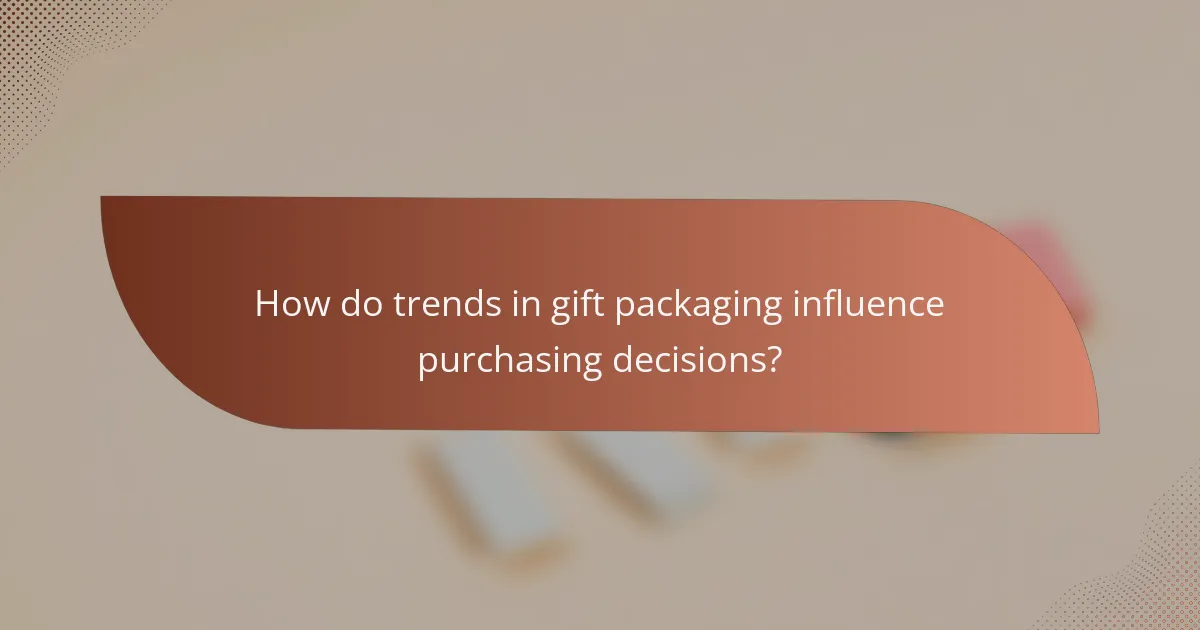
How do trends in gift packaging influence purchasing decisions?
Trends in gift packaging significantly affect purchasing decisions by shaping consumer perceptions and preferences. As shoppers become more conscious of environmental impact, aesthetics, and functionality, these factors increasingly drive their choices at the point of sale.
Impact of sustainability on buying choices
Sustainability has become a crucial factor in consumer purchasing decisions, with many shoppers preferring eco-friendly packaging options. Brands that utilize recyclable, biodegradable, or reusable materials often attract environmentally conscious consumers, leading to increased sales.
For example, packaging made from recycled paper or plant-based materials can enhance a brand’s appeal. Offering clear information about sustainability practices can further influence buyers, as transparency builds trust and loyalty.
Role of aesthetics in consumer attraction
Aesthetics play a vital role in attracting consumers to gift packaging. Visually appealing designs, colors, and textures can create an emotional connection, making products more desirable. Unique and stylish packaging can differentiate a brand from competitors, especially during holidays or special occasions.
For instance, limited-edition packaging with artistic designs can entice buyers looking for special gifts. Brands should consider seasonal trends and target demographics when designing packaging to maximize visual impact and consumer interest.
Importance of functionality
Functionality in gift packaging is essential for enhancing the overall consumer experience. Packaging that is easy to open, resealable, or includes compartments can add value and convenience, making it more attractive to buyers.
For example, a gift box that doubles as storage or a bag that can be reused for other purposes can appeal to practical-minded consumers. Brands should prioritize user-friendly designs that enhance usability while maintaining aesthetic appeal to meet diverse consumer needs.

What are the popular styles of gift packaging in e-commerce?
Popular styles of gift packaging in e-commerce reflect current consumer preferences and trends. Minimalist designs, vintage aesthetics, and bold colors are leading choices that enhance the unboxing experience and appeal to various customer demographics.
Minimalist packaging
Minimalist packaging emphasizes simplicity and functionality, often using neutral colors and clean lines. This style appeals to consumers who appreciate modern aesthetics and sustainability, as it typically involves less material and waste.
When choosing minimalist packaging, consider using recyclable materials and simple designs that focus on the product itself. Brands like Apple and Muji exemplify this approach, creating a sophisticated look that enhances the perceived value of their products.
Vintage and retro designs
Vintage and retro packaging evokes nostalgia and charm, often featuring classic patterns and typography. This style resonates with consumers looking for a personal touch and a connection to the past, making it ideal for gifts.
To effectively use vintage designs, incorporate elements like kraft paper, twine, or retro graphics that reflect the era you want to evoke. Brands like Coca-Cola and various artisanal shops successfully leverage this style to create memorable unboxing experiences.
Bold colors and patterns
Bold colors and patterns in gift packaging attract attention and convey excitement. This style is particularly popular for celebrations like birthdays and holidays, where vibrant designs can enhance the festive atmosphere.
When opting for bold packaging, consider the target audience and occasion. Bright colors and playful patterns can be effective for children’s gifts, while more sophisticated designs may appeal to adults. Brands like Hallmark often utilize this strategy to create eye-catching, celebratory packaging.
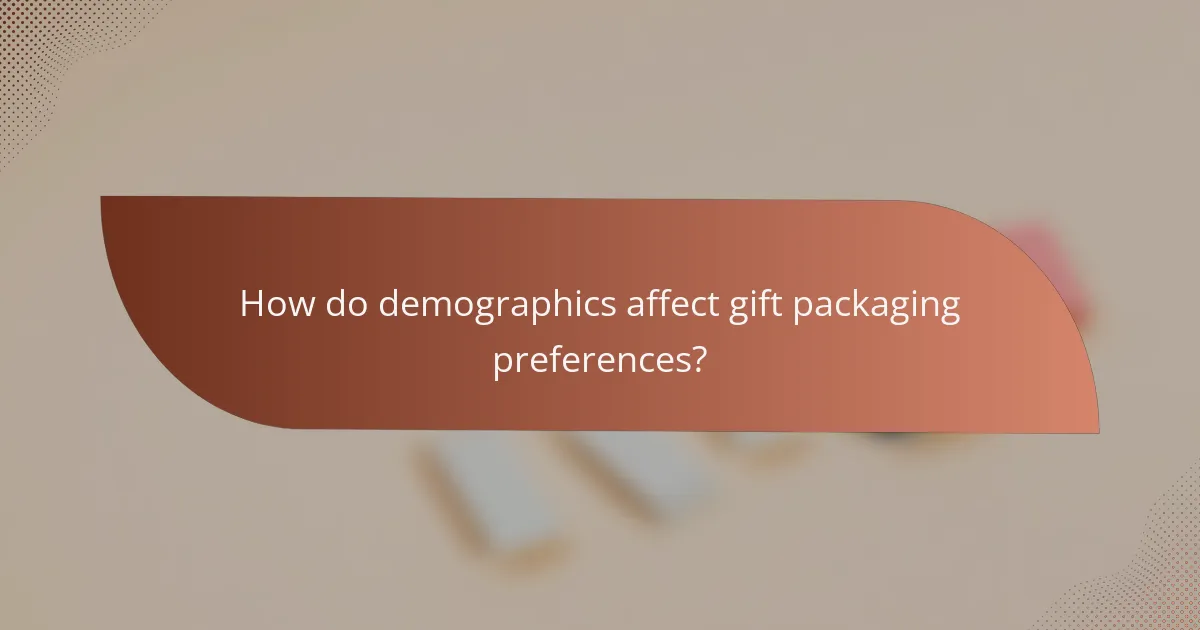
How do demographics affect gift packaging preferences?
Demographics significantly influence gift packaging preferences, shaping choices based on age, values, and lifestyle. Understanding these preferences helps businesses tailor their offerings to meet the demands of different consumer groups.
Millennial preferences for eco-friendly options
Millennials prioritize sustainability in their gift packaging choices, often opting for materials that are recyclable or biodegradable. This generation is inclined to support brands that demonstrate environmental responsibility, which can include using minimal packaging or innovative materials like plant-based plastics.
When selecting eco-friendly options, brands should consider incorporating natural fibers, recycled paper, or reusable packaging solutions. Offering clear labeling on sustainability can enhance appeal, as consumers appreciate transparency about the environmental impact of their purchases.
Gen Z demand for personalization
Gen Z consumers seek personalized gift packaging that reflects their unique identity and style. This demographic values customization, whether through bespoke designs, tailored messages, or interactive elements that enhance the gifting experience.
To cater to this demand, brands can offer customizable packaging options, such as monogramming or themed designs that resonate with current trends. Engaging with consumers on social media to showcase personalized packaging ideas can also drive interest and sales.
Baby Boomers favoring traditional styles
Baby Boomers generally prefer traditional gift packaging styles, valuing classic aesthetics and quality materials. This demographic often associates familiar designs with nostalgia and sentimentality, making them less inclined to experiment with modern trends.
Brands targeting Baby Boomers should focus on elegant, timeless packaging options, such as high-quality wrapping paper, ribbons, and gift boxes. Emphasizing craftsmanship and durability can resonate well with this audience, reinforcing their preference for traditional styles.
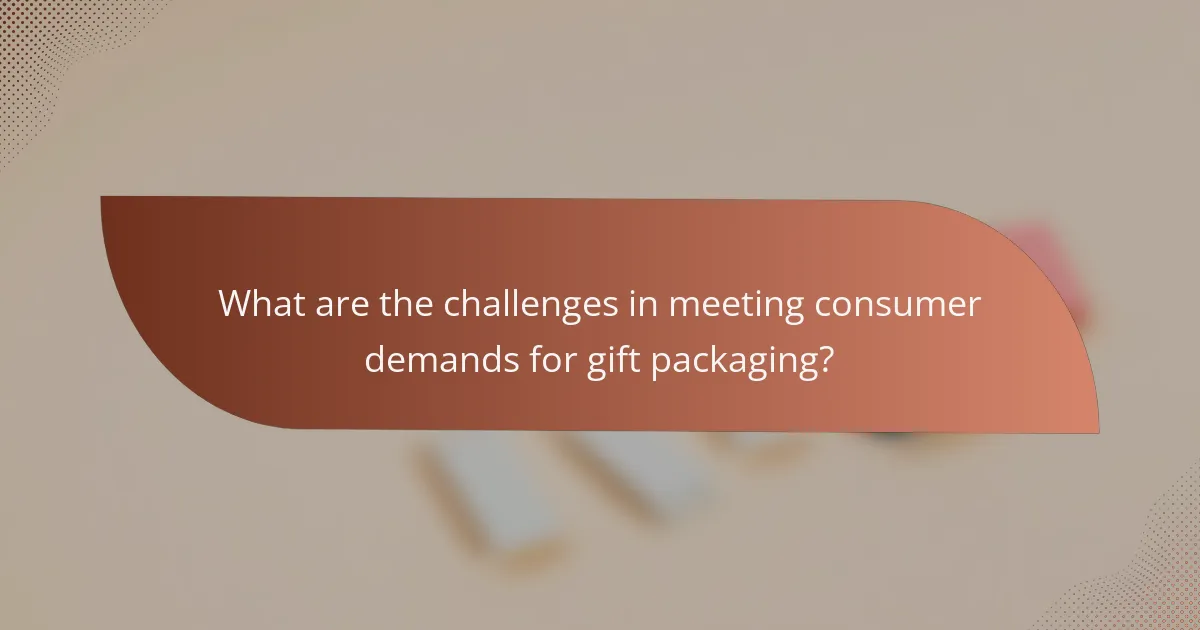
What are the challenges in meeting consumer demands for gift packaging?
Meeting consumer demands for gift packaging involves navigating various challenges, including sustainability concerns, cost constraints, and the need for personalization. Brands must balance these factors to create appealing packaging that resonates with consumers while remaining economically viable.
Consumer Expectations for Sustainability
Consumers increasingly expect gift packaging to be environmentally friendly, which poses a challenge for brands. Sustainable materials, such as recycled paper or biodegradable plastics, are in high demand, but they can be more expensive than traditional options. Brands must weigh the benefits of eco-friendly packaging against potential cost increases.
To meet these expectations, companies can explore innovative materials and processes that reduce environmental impact. For example, using minimal packaging or sourcing materials locally can enhance sustainability while appealing to eco-conscious consumers.
Cost vs. Quality Dilemma
Balancing cost and quality in gift packaging is a significant challenge for many businesses. High-quality packaging can enhance the perceived value of a product, but it often comes with higher production costs. Brands need to find a sweet spot that satisfies consumer expectations without sacrificing profitability.
One approach is to invest in packaging that provides a premium feel without excessive costs. For instance, using simple yet elegant designs can create a high-end look while keeping expenses manageable. Regularly reviewing suppliers and negotiating bulk pricing can also help control costs.
Personalization Trends
Personalization in gift packaging is becoming increasingly popular, as consumers seek unique and tailored experiences. However, implementing personalization can complicate production processes and increase lead times. Brands must consider how to efficiently offer customized options without overwhelming their operations.
To effectively incorporate personalization, businesses can utilize technology such as digital printing, which allows for quick adjustments to packaging designs. Offering a limited range of customizable features can also streamline the process while still providing a personal touch that appeals to consumers.
